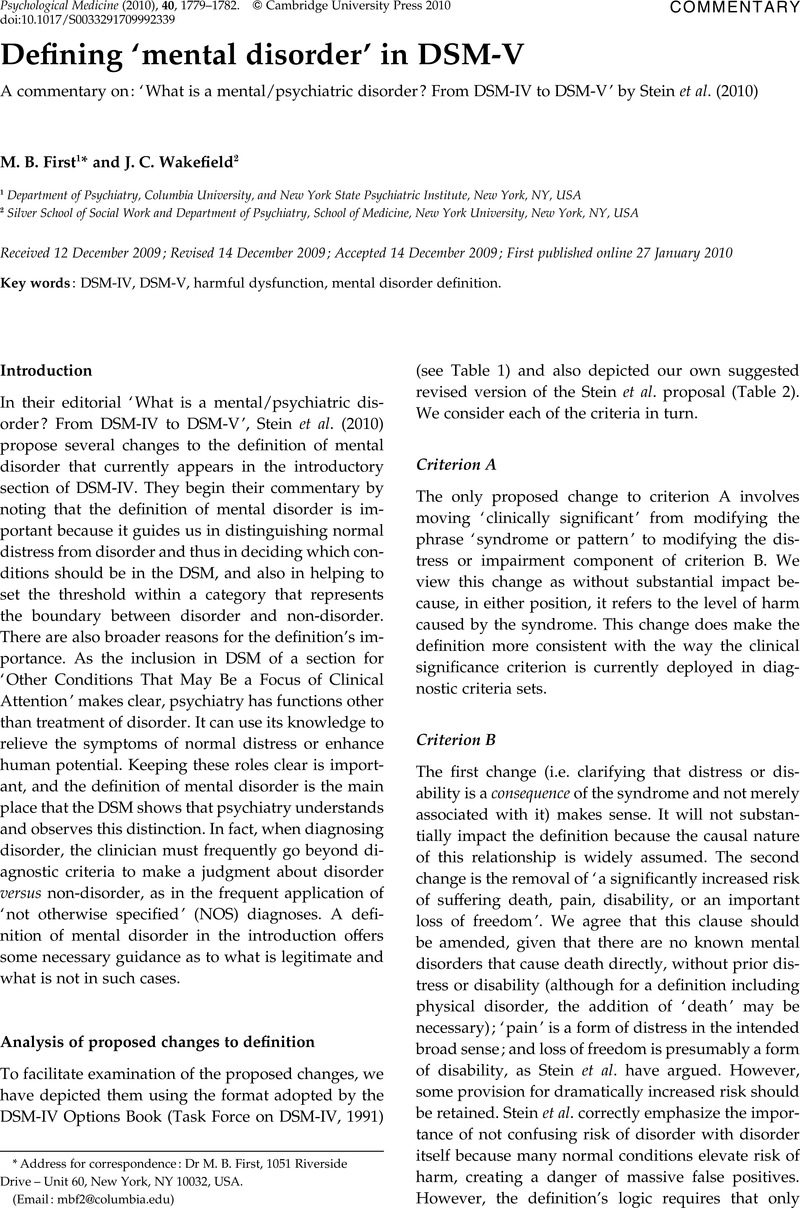Crossref Citations
This article has been cited by the following publications. This list is generated based on data provided by Crossref.
Lawrence, Anne A.
2010.
Proposed Revisions to Gender Identity Disorder Diagnoses in the DSM-5.
Archives of Sexual Behavior,
Vol. 39,
Issue. 6,
p.
1253.
Verhoeff, Berend
2010.
Drawing borders of mental disorders: An interview with David Kupfer.
BioSocieties,
Vol. 5,
Issue. 4,
p.
467.
STEIN, DAN J.
PHILLIPS, KATHARINE A.
BOLTON, DEREK
FULFORD, K. W. M.
SADLER, JOHN Z.
and
KENDLER, KENNETH S.
2010.
Letter to the Editor: Response to the commentaries on ‘What is a mental/psychiatric disorder?’.
Psychological Medicine,
Vol. 40,
Issue. 11,
p.
1931.
Lawrence, Anne A.
2011.
Do Some Men Who Desire Sex Reassignment Have A Mental Disorder? Comment on Meyer-Bahlburg (2010).
Archives of Sexual Behavior,
Vol. 40,
Issue. 4,
p.
651.
DIRKX, J.
2011.
Psychoanalyse en evidentie.
Tijdschrift voor Psychotherapie,
Vol. 37,
Issue. 5,
p.
321.
Vaidyanathan, U.
Nelson, L. D.
and
Patrick, C. J.
2012.
Clarifying domains of internalizing psychopathology using neurophysiology.
Psychological Medicine,
Vol. 42,
Issue. 3,
p.
447.
Malón, Agustin
2012.
Pedophilia: A Diagnosis in Search of a Disorder.
Archives of Sexual Behavior,
Vol. 41,
Issue. 5,
p.
1083.
Pierre, Joseph M
2012.
Mental Illness and Mental Health: Is the Glass Half Empty or Half Full?.
The Canadian Journal of Psychiatry,
Vol. 57,
Issue. 11,
p.
651.
Frick, Paul J.
and
Nigg, Joel T.
2012.
Current Issues in the Diagnosis of Attention Deficit Hyperactivity Disorder, Oppositional Defiant Disorder, and Conduct Disorder.
Annual Review of Clinical Psychology,
Vol. 8,
Issue. 1,
p.
77.
Kecmanovic, Dusan
2013.
The DSM-5 definition of mental disorder.
Australian & New Zealand Journal of Psychiatry,
Vol. 47,
Issue. 4,
p.
393.
Wakefield, Jerome C
and
First, Michael B
2013.
Clarifying the Boundary between Normality and Disorder: A Fundamental Conceptual Challenge for Psychiatry.
The Canadian Journal of Psychiatry,
Vol. 58,
Issue. 11,
p.
603.
Pierre, Joseph M.
2013.
Making the DSM-5.
p.
105.
Switzer, Galen E.
Dew, Mary Amanda
and
Bromet, Evelyn J.
2013.
Handbook of the Sociology of Mental Health.
p.
115.
Witkiewitz, Katie
King, Kevin
McMahon, Robert J.
Wu, Johnny
Luk, Jeremy
Bierman, Karen L.
Coie, John D.
Dodge, Kenneth A.
Greenberg, Mark T.
Lochman, John E.
and
Pinderhughes, Ellen E.
2013.
Evidence for a Multi-Dimensional Latent Structural Model of Externalizing Disorders.
Journal of Abnormal Child Psychology,
Vol. 41,
Issue. 2,
p.
223.
Reid, Rory C.
and
Kafka, Martin P.
2014.
Controversies About Hypersexual Disorder and the DSM-5.
Current Sexual Health Reports,
Vol. 6,
Issue. 4,
p.
259.
Ishihara, Kohji
2014.
Descriptive Methods and the “Dysfunction” Model in Psychiatry.
Kagaku tetsugaku,
Vol. 47,
Issue. 2,
p.
17.
Ghaemi, S. N.
Dalley, S.
Catania, C.
and
Barroilhet, S.
2014.
Bipolar or borderline: a clinical overview.
Acta Psychiatrica Scandinavica,
Vol. 130,
Issue. 2,
p.
99.
Gatti, Uberto
Rocca, Gabriele
Graap, Caroline
and
Tremblay, Richard E.
2014.
Psychiatrie de l'enfant et de l'adolescent.
p.
283.
Thyer, Bruce A.
2015.
Critical Thinking in Clinical Assessment and Diagnosis.
p.
45.
Wakefield, J. C.
2015.
DSM-5, psychiatric epidemiology and the false positives problem.
Epidemiology and Psychiatric Sciences,
Vol. 24,
Issue. 3,
p.
188.



